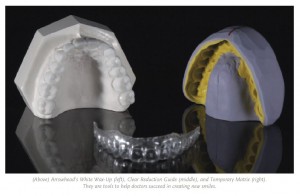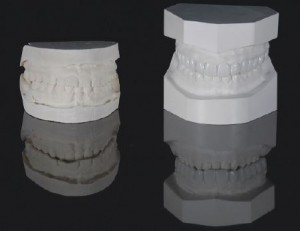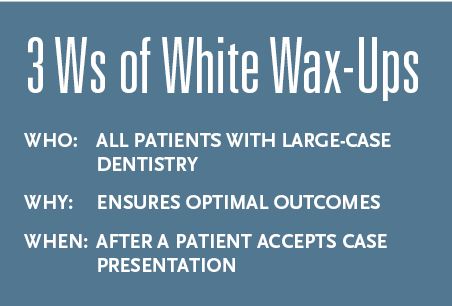
A Stuning 3D Model Shows Patients What’s Possible.
Some dentists hear the term White Wax-Up and have a preconceived notion about it. But most dentists really don’t understand just how beneficial White Wax-Ups can be for large-case dentistry. Diagnostic wax-ups can solve many problems associated with large cases and will bring consistency to the outcomes of your cases.
I have been using White Wax-Ups from Arrowhead Dental Laboratory as a diagnostic tool for many years. For me, it is a guide for the direction I can go with patients, particularly those with worn dentition. The White Wax-Up is a predictability tool for learning more about the patient and determining what can be done in a patient’s mouth. I use it to learn many things about the patient— how much more I can open the mouth, what kind of tooth dimension will work, and what can be done to alleviate pain in the jaw joints. A White Wax-Up is a strong indication of what can be done for patients.
Years ago, we used computer imaging to import smiles from a library and create an artificial preview of a smile. Too often, the smile did not suit the patient’s anatomy, so the before-and-after didn’t really match. When we started working with the patient’s anatomy, sometimes we couldn’t re-create the same look. Patients were often not happy with the outcome.
A White Wax-Up gives a true indication of the anatomy of the patient. It’s based on preliminary impressions of the patient. Once it is ready, the dentist can work within the confines of the mouth’s true parameters to get an outcome that will satisfy everyone. The new teeth also last better with a White Wax-Up. They do not chip and break because the new smile fits the anatomy of the patient.
Benefits of a White Wax-Up
For my patients, a wax-up is a necessity. A White Wax-Up simplifies prep for the dentist, saving time and stress. It provides an opportunity for the patient to “test drive” the mouth before things are permanent, increasing patient satisfaction with the finished product and decreasing the chance of failure. A White Wax-Up improves the dentist’s communication with the lab and eliminates guesswork. The wax-up is a diagnostic tool that keeps you in structure. Not having one creates a lot stress! Once you have this structure, you can overlay a reduction guide and start the actual execution of the case in prepping.
Without a White Wax-Up, doctors’ axial inclinations of the preps can be all over the place. They might over-prep or under-prep or angle the teeth in the wrong direction. With the wax-up as a guide, a dentist has a framework that takes her or him through all the steps required for an optimal outcome. It’s predictable. It’s adaptable. It’s sustainable throughout the whole process. If you spend the time with the diagnostics, then it should be fun on prep day!
The White Wax-Up not only lets you see what the case is going to look like, but you can then show the patient, so he or she also knows what to expect.
After prepping, you have to temporize. You have to provisionalize the teeth. This is where the Sil-Tech matrix, which is made from the White Wax-Up, comes in. You can inject acrylic temporary material into the Sil-Tech matrix and then create a model made from the White Wax-Up and insert it in the patient’s mouth. You can’t do that with a picture!
With these tools, dentists can test the environment—meaning the look, the feel, and the functionality of the new teeth. You can determine if the Shimbashi measurement is right, if you chose the right length, if the gum heights are correct, and whether the axial inclinations are right. All the decisions made in the diagnostics can be tested. It’s an opportunity to “test drive” the design before it’s fabricated.
The patient can go home with acrylic temporaries to see how everything feels. Then he or she returns in 48 to 72 hours, so you can look at the smile—the shape, the size, the shade, and the gum height. You can test everything. It is the perfect time to work everything out. If the patient gives the approval, then you can order the finals. I find it’s rare that a patient doesn’t like it.
Using White Wax-Ups is also a huge time saver! For a dentist who is doing their first full arch, I recommend scheduling a morning to work on it—that’s five hours. If they didn’t use the White Wax-Up, it would be an all-day event, and an extremely stressful one as well.
A White Wax-Up also helps improve the final product. When communicating with the lab, there is no guesswork if you use the wax-up because it is sent back with the case. All you have to do is tell the lab, “follow the White Wax-Up.” The only time there is a variance is if you’ve made some substantial changes on the temporaries. But in such cases, all you have to do is take an impression of the temporaries in the patient’s mouth, pull that out, tell the lab, “follow this exactly,” and they can do it.
Communication becomes easy, much better than a long dissertation that dentists often write to a lab, which a technician is left to try to figure out.
The White Wax-Up really becomes a differentiator in the marketplace. Once it becomes commonplace in your practice, you begin to get the reputation for being able to deliver the Mercedes-Benz® outcome for your patients!
Process
Now that you know why White Wax-Ups are beneficial, let’s talk a little about the process. The starting point is taking the diagnostics of the patient. The first thing I look at is the Shimbashi measurement—a measurement from a particular point on the upper central incisor to the lower central incisor. On typical cases where someone’s dentition and facial aesthetics look adequate, the measurement is usually between 16 and 18 millimeters from that upper central to the lower central.
The Shimbashi becomes a quick and easy ascertainment of wear. If someone has a Shimbashi of 12, that means that their teeth on the upper and lower have worn to such a position that their nose and chin are getting closer together. When that happens, it throws the muscles off. When the muscles are off, they can overheat, and the patient starts getting headaches and popping and clicking in the jaw joint.
After taking the Shimbashi measurement, you can determine how much to open the bite to fix the situation of the muscles and the jaw joint, and then get the aesthetics that the patient wants. You can open his or her bite in accordance with what is comfortable for the muscles and jaw joints.
The next step is to determine the measurement of the front anterior central that matches the facial type. There are three main facial types. One is a square boxy head, known as brachiocephalic. Next are the square taper and ovoid. These two together are called mesocephalic. Finally, there are the long skinny faces called dolichocephalic.
Why is this important? Dentists should design teeth that match the facial type. If I put some nice long teeth on a brachiocephalic, they’re going to break those right off. These individuals chew left to right to eat. If we put in nice long teeth and nice high cusps in the back, they’re going to rip them apart. Instead, the posterior teeth have to be almost like a flat tooth in order to give them clearance in the front, so when they slide left and right they don’t climb or get locked in.
Once you determine the facial shape, you and the patient can decide the look of the smile you will create. On the Arrowhead laboratory slip, there are a number of different looks, such as “Enhanced,” “Hollywood,” or “Natural.” You can use the White Wax-Up as a diagnostic tool to see what smile you will be able to create.
Another component to the White Wax-Up is the importance of taking great photography of someone’s smile. From photography, you can determine if you have recession on one tooth and whether you should bring the other teeth up or bring the gum down. You can decide whether you need to include an appointment with a periodontist for gum grafting as part of the process. All these decisions play a role in the final outcome.
The gums are a critical part of the equation. The gingiva provide the framework to the picture, which is the teeth. When a doctor focuses only on the teeth, it shows. I see pictures in journals where the teeth look great, but the gum heights are all over the place. They look bulbous. They look inflamed. This can be avoided if you look at the gums and gum health first to make sure the teeth look natural, healthy, and beautiful. On the White Wax-Up, the doctor can determine where that gum should go. In most cases, you can lift gums one to two millimeters. Gingival height is important for the White Wax-Up, so that the symmetry from left to right looks the same.
Ensuring Success
The White Wax-Up is a guide that improves the chances of success when used correctly. Some additional strategies can also help. Before you start the diagnostic process, determine whether the patient has any symptoms that should be dealt with: headaches, jaw clicking, or other indicators of problems with bite. These problems have to be eliminated and mapped out before moving forward. Once any symptoms are taken care of, I have five “must-dos” that are keys to success:
- Provide Accurate Models. Since you are basing your success on the White Wax-Up, you must have impeccable impressions of the upper arch and lower arch—especially the upper arch, where we see hamular notches in the posterior and good peripheral extension. You have to see the anatomy well because the Sil-Tech will be based on the anatomy of the White Wax-Up. Do not send in inadequate models!
- Include Good Photography. With good photographs, you can examine and analyze things differently after the patient has left. Photography is not only a great communication tool for case presentations, it’s also great for letting the technician see what kind of patient they are working with—their smile line, their facial type, and their gum line.
- Make Smile Guide Determination. Too often, doctors don’t choose a particular smile—whether it is Enhanced, Hollywood, or Natural—in accordance with what they’re looking at for facial types. The central incisors are chosen with a formula of width divided by length in a percentage range of 75 to 80 percent. Seventy-five percent is closer to the long face. Seventy-eight percent is perfect for mesocephalic, and brachiocephalic is about 80 percent.
- Determine the Golden Shimbashi. In the past, doctors often used a formula to figure out the Golden Shimbashi with seven or eight questions. I found that doctors weren’t taking the time to fill it out, so we simplified it. If the doctor provides the width and length of central incisor, the lab can determine the golden proportion.
- Perform Periodontal Probings. The probings are in the anterior eight teeth on the top. You have to probe the pocket depths of those gums so that you can determine if you can truly take that gum height to where they want it.
Keep in mind that not all wax-ups are the same! I have seen some that look terrible! When you present wax-ups to a patient, they should look white, clean and professional. First impressions are important, and if you can present something that looks exquisite, that’s a reflection on you and what you will deliver. It can increase patient trust and confidence.
This is particularly true for prefabricated wax-ups. With prefabricated wax-ups, dentists can spend a lot of time trying to make the provisionals work, and they often still don’t fit the patient. Such wax-ups are kind of an overlay, like a tomato on fence post. They end up looking bulbous and bulky. Arrowhead’s White Wax-Ups are a true representation of what the patient is going to get, not a prefabricated model.
The White Wax-Up that Arrowhead provides is more than just the wax mock-up of the end result. You also get a Sil-Tech matrix that gives the true emergence profile, so you can develop the smile from those teeth, instead of using prefabs.
Selling the Patient
When it comes to White Wax-Ups, how do you position them in the case presentation process? It is not a bad idea to have a model to use as a demo. Even a new doctor without any cases may want to invest in one. That way, you can have a before-and-after to show the patient how you will proceed. When the doctor talks to the patient in the case presentation, it gives the patient confidence because the doctor spent the time to do the diagnosis.
A lot of doctors ask me if they should order a patient’s White Wax-Up before the case presentation. My rule is not to order it until you’ve done the case presentation, because if the White Wax-Up is done and the patient hasn’t accepted treatment yet, then they’ve just spent anywhere from $500 to $1,000 on a wax-up that is now useless.
The only time I break from my rule is when I see that we need to do the lower six. With such a case, I go ahead and have the lower six wax-up done as well, and I don’t charge the patient. I just want the patient to see the difference. It’s a risk that I prefer to take (and one that pays off about 80 percent of the time) so I can get to do the case. I think when you’re doing cosmetics, anytime you’re doing aesthetics of the front upper six or eight teeth, there absolutely should be a White Wax-Up. That’s a hard-and-fast rule. Also, if the Shimbashi drops down below 14.5 millimeters, there should be a White Wax-Up.
A sample White Wax-Up is a nice way to show what the process looks like without doing an individualized White Wax-Up on every patient who walks in the door. In my practice, I typically do not order a specific wax-up until after the case presentation or the diagnostic appointment. When I present the case and the fee, I include the cost of the White Wax-Up. I don’t position it as a separate cost. Once they accept a case, you lump it in. It’s all one fee.
If patients have objections to the White Wax-Up because of cost or other factors, tell them that using one will allow you to be as precise as possible and will give them the chance to test things out in advance. Communicate that the White Wax-Up is an important step in determining the preparation work and the fit. It is worth the expense to have a great final product.













